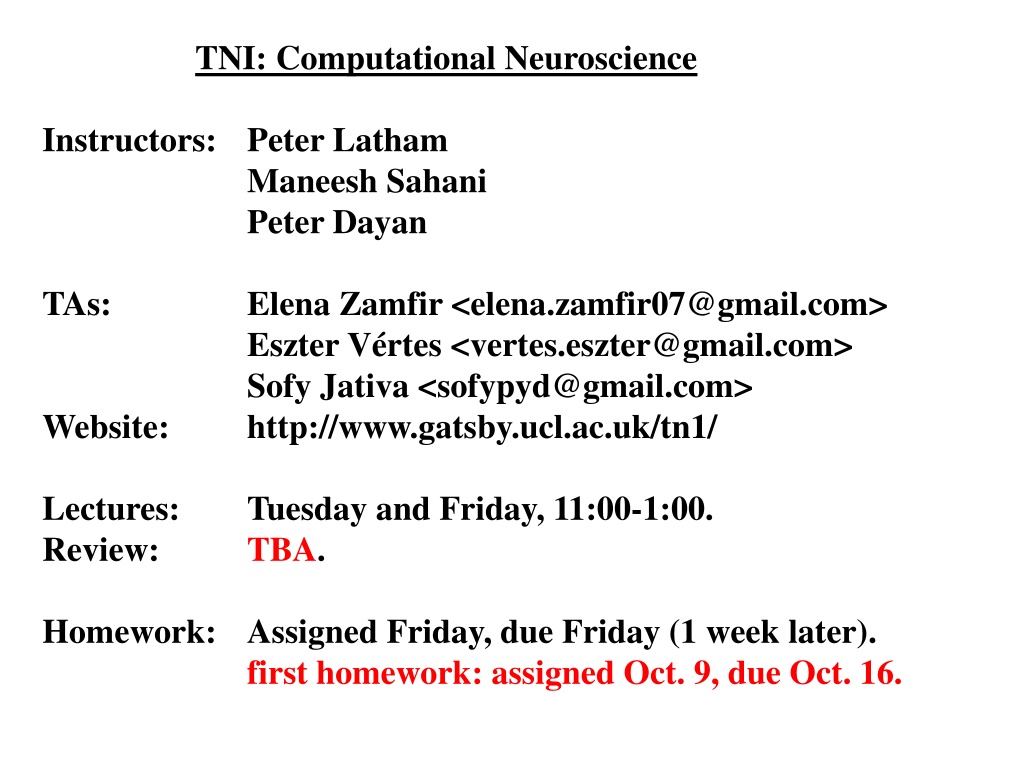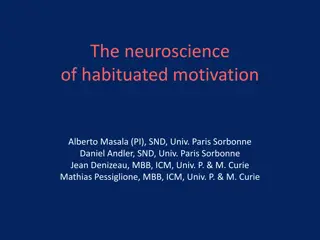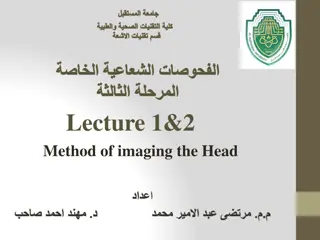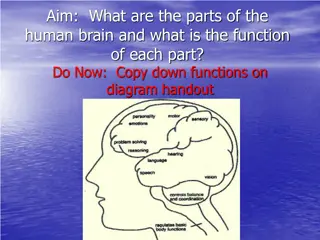Neuroscience at UCL: Computational Brain Insights
Delve into the world of computational neuroscience with instructors Peter Latham, Maneesh Sahani, and Peter Dayan at University College London. Explore the brain's intricacies, from basic facts to mathematical foundations, and uncover the hidden complexities of neural processes. Engage in lectures, reviews, and hands-on activities to deepen your understanding of the brain's workings. Discover the power of your brain and its remarkable capabilities as you navigate through the course curriculum. Join the journey of unraveling the mysteries of the mind through the lens of computational neuroscience.
Download Presentation

Please find below an Image/Link to download the presentation.
The content on the website is provided AS IS for your information and personal use only. It may not be sold, licensed, or shared on other websites without obtaining consent from the author.If you encounter any issues during the download, it is possible that the publisher has removed the file from their server.
You are allowed to download the files provided on this website for personal or commercial use, subject to the condition that they are used lawfully. All files are the property of their respective owners.
The content on the website is provided AS IS for your information and personal use only. It may not be sold, licensed, or shared on other websites without obtaining consent from the author.
E N D
Presentation Transcript
TNI: Computational Neuroscience Instructors: Peter Latham Maneesh Sahani Peter Dayan TAs: Elena Zamfir <elena.zamfir07@gmail.com> Eszter V rtes <vertes.eszter@gmail.com> Sofy Jativa <sofypyd@gmail.com> http://www.gatsby.ucl.ac.uk/tn1/ Website: Lectures: Review: Tuesday and Friday, 11:00-1:00. TBA. Homework: Assigned Friday, due Friday (1 week later). first homework: assigned Oct. 9, due Oct. 16.
Outline 1. Basic facts about the brain. 2. What it is we really want to know about the brain. 3. How that relates to the course. 4. The math you will need to know. 5. Then we switch over to the white board, and the fun begins!
Outline 1. Basic facts about the brain. 2. What it is we really want to know about the brain. 3. How that relates to the course. 4. The math you will need to know. 5. Then we switch over to the white board, and the fun begins!
Disclaimer: this is biology. - There isn t a single fact I know of that doesn t have an exception. - Every single process in the brain (including spike generation) has lots of bells and whistles. It s not known whether or not they re important. I m going to ignore them, and err on the side of simplicity. - I may or may not be throwing the baby out with the bathwater.
Your cortex unfolded neocortex (sensory and motor processing, cognition) 6 layers ~30 cm ~0.5 cm subcortical structures (emotions, reward, homeostasis, much much more)
Your cortex unfolded 1 cubic millimeter, ~10-3 grams
1 mm3 of cortex: 1 mm2 of a CPU: 50,000 neurons 1000 connections/neuron (=> 50 million connections) 4 km of axons 1 million transistors 2 connections/transistor (=> 2 million connections) .002 km of wire whole brain (2 kg): whole CPU: 1011 neurons 1014 connections 8 million km of axons 20 watts 109 transistors 2 109 connections 2 km of wire scaled to brain: MW
1 mm3 of cortex: 1 mm2 of a CPU: 50,000 neurons 1000 connections/neuron (=> 50 million connections) 4 km of axons 1 million transistors 2 connections/transistor (=> 2 million connections) .002 km of wire whole brain (2 kg): whole CPU: 1011 neurons 1014 connections 8 million km of axons 20 watts 109 transistors 2 109 connections 2 km of wire scaled to brain: MW
1 mm3 of cortex: 1 mm2 of a CPU: 50,000 neurons 1000 connections/neuron (=> 50 million connections) 4 km of axons 1 million transistors 2 connections/transistor (=> 2 million connections) .002 km of wire whole brain (2 kg): whole CPU: 1011 neurons 1014 connections 8 million km of axons 20 watts 109 transistors 2 109 connections 2 km of wire scaled to brain: MW
There are about 10 billion cubes of this size in your brain! 10 microns .01 mm
Your brain is full of neurons dendrites (input) soma spike generation axon (output) 1 mm (1000 m) 20 m mm - meter (1000-1,000,000 m)
~1900 (Ramon y Cajal) ~2010 (Mandy George) ~100 m
dendrites (input) soma spike generation axon (output) +20 mV 1 ms voltage -50 mV 100 ms time
dendrites (input) soma spike generation axon (wires) +20 mV 1 ms voltage -50 mV 100 ms time
synapse current flow
+20 mV voltage -50 mV 100 ms time
neuron i neuron j neuron j emits a spike: EPSP (excitatory post-synaptic potential) V on neuron i 0.5 mV t 10 ms
neuron i neuron j neuron j emits a spike: IPSP (inhibitory post-synaptic potential) V on neuron i t 10 ms 0.5 mV
neuron i neuron j neuron j emits a spike: changes with learning IPSP V on neuron i t amplitude wij 10 ms 0.5 mV
Simplest possible network equations: ~10 ms dVi (Vi Vrest) + jwijgj(t) = subtheshold integration dt +20 mV voltage Vthresh Vrest 100 ms time
Simplest possible network equations: ~10 ms dVi (Vi Vrest) + jwijgj(t) = subtheshold integration dt Vi reaches threshold ( -50 mV): - a spike is emitted - Vi is reset to Vrest ( -65 mV) +20 mV 1 ms voltage -50 mV -65 mV 100 ms time
Simplest possible network equations: ~10 ms dVi (Vi Vrest) + jwijgj(t) = subtheshold integration dt Vi reaches threshold ( -50 mV): - a spike is emitted - Vi is reset to Vrest ( -65 mV) +20 mV voltage -50 mV -65 mV 100 ms time
Simplest possible network equations: each neuron receives about 1,000 inputs. about 1,000 nonzero terms in this sum. ~10 ms dVi (Vi Vrest) + jwijgj(t) = dt ~5 ms t Vi reaches threshold ( -50 mV): - a spike is emitted - Vi is reset to Vrest ( -65 mV) spike times, neuron j +20 mV voltage -50 mV -65 mV 100 ms time
Simplest possible network equations: dVi (Vi Vrest) + jwijgj(t) = dt w is 1011 1011 w is very sparse: each neuron contacts ~103 other neurons. w evolves in time (learning): dwij dt s Fij (Vi ,Vj; global signal) = >> we think spikes on neuron j
Simplest possible network equations: dVi (Vi Vrest) + jwijgj(t) = dt w is 1011 1011 w is very sparse: each neuron contacts ~103 other neurons. w evolves in time (learning): dwij dt s Fij (Vi ,Vj; global signal) = >> we think spikes on neuron j
your brain ~1011 neurons excitatory neuron (80%) ~1,000 connections ~90% short range ~10% long range
your brain ~1011 neurons excitatory neuron (80%) inhibitory neuron (20%) ~1,000 connections ~100% short range
What you need to remember: When a neurons spikes, that causes a small change in the voltage of its target neurons: - if the neuron is excitatory, the voltage goes up on about half of its 1,000 target neurons on the other half, nothing happens - if the neuron is inhibitory, the voltage goes down on about half if its 1,000 target neurons on the other half, nothing happens a different half every time there s a spike! why nothing happens is one of the biggest mysteries in neuroscience along with why we sleep another huge mystery
your brain at a microscopic level ~1011 neurons excitatory neuron (80%) inhibitory neuron (20%)
there is lots of structure at the macroscopic level sensory processing (input) action selection motor processing (output) memory
there is lots of structure at the macroscopic level lots of visual areas action selection motor processing (output) auditory areas memory
Outline 1. Basic facts about the brain. 2. What it is we really want to know about the brain. 3. How that relates to the course. 4. The math you will need to know. 5. Then we switch over to the white board, and the fun begins!
In neuroscience, unlike most of the hard sciences, its not clear what we want to know. The really hard part in this field is identifying a question that s both answerable and brings us closer to understanding how the brain works.
For instance, the question how does the brain works? is not answerable (at least not directly, or any time soon) but it will bring us (a lot!) closer to understanding how the brain works. On the other hand, the question what s the activation curve for the Kv1.1 voltage-gated potassium channels? is answerable, but it will bring us (almost) no closer to understanding how the brain works.
Most questions fall into one of these two categories: - interesting but not answerable - not interesting but answerable
Im not going to tell you what the right questions are. But in the next several slides, I m going to give you a highly biased view of how we might go about identifying the right questions.
Simplest possible network equations: dVi (Vi Vrest) + jwijgj(t) = dt dwij dt s Fij (Vi ,Vj; global signal) = This might be a reasonably good model of the brain. If it is, we just have to solve these equations!
Simplest possible network equations: dVi (Vi Vrest) + jwijgj(t) = dt dwij dt s Fij (Vi ,Vj; global signal) = Techniques physicists use: look for symmetries/conserved quantities look for optimization principles look at toy models that can illuminate general principles perform simulations These have not been all that useful in neuroscience!
Simplest possible network equations: dVi (Vi Vrest) + jwijgj(t) = dt dwij dt s Fij (Vi ,Vj; global signal) = Things physicists like to compute: averages correlations critical points These have not been all that useful in neuroscience!
Simplest possible network equations: dVi (Vi Vrest) + jwijgj(t) = dt dwij dt s Fij (Vi ,Vj; global signal) = That s because these equations depend on about 1014 parameters (1011 neurons 103 connections/neuron). It s likely that the region of parameter space in which these equations behave anything like the brain is small. small = really really small
The brains parameter space ~1014 dimensional region of brain- like behavior size = 10-really big number
The brains parameter space ~1014 dimensional region of brain- like behavior size = 10-really big number nobody knows how big the number is. my guess: much much larger than 1,000. the Human Brain Project s guess: less than 5.
Possibly the biggest problem faced by neuroscientists working at the circuit level is finding the very small set of parameters that tell us something about how the brain works. One strategy for finding the right parameters: try to find parameters such that the equations mimic the kinds of computations that animals perform.
your brain sensory processing (input) action selection motor processing (output)
x r latent variables peripheral spikes sensory processing r^ direct code for latent variables cognition memory action selection brain r'^ direct code for motor actions motor processing r' peripheral spikes x' motor actions

























